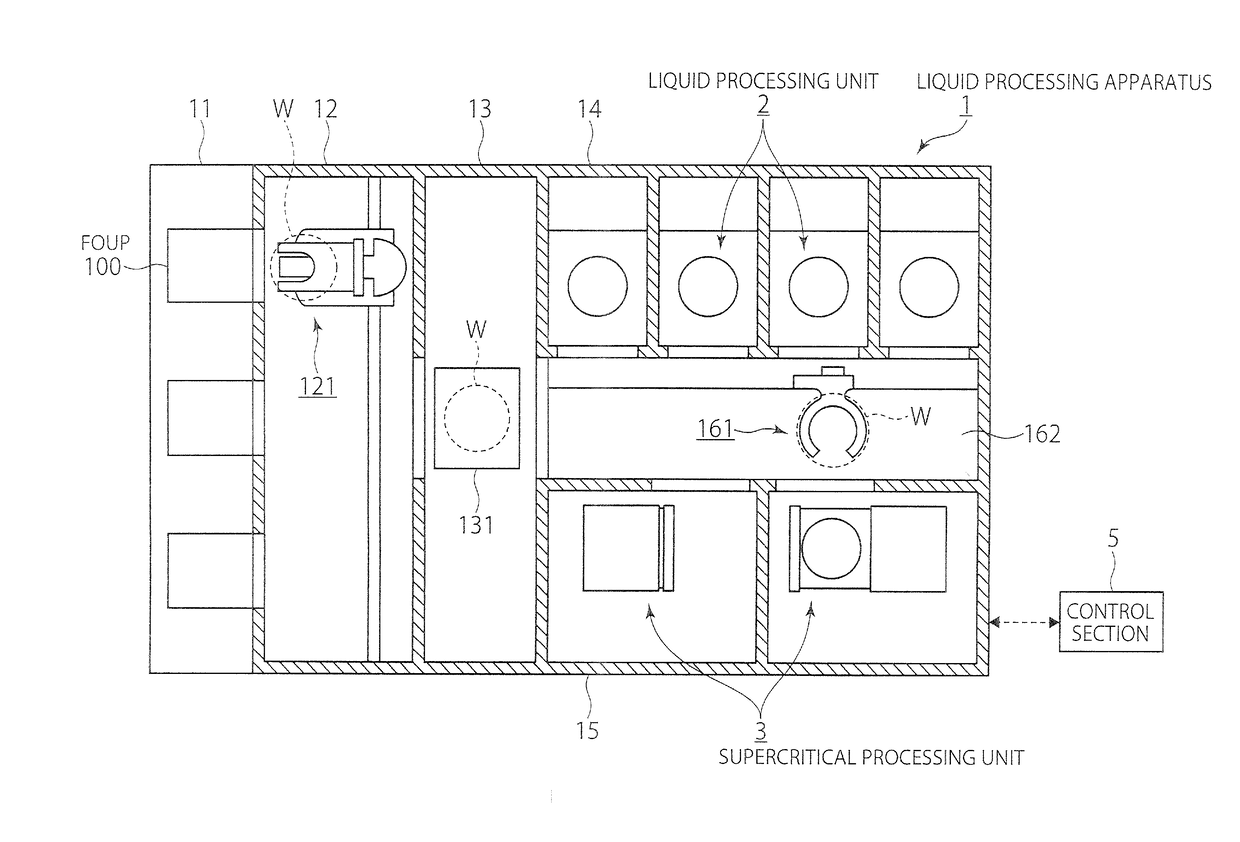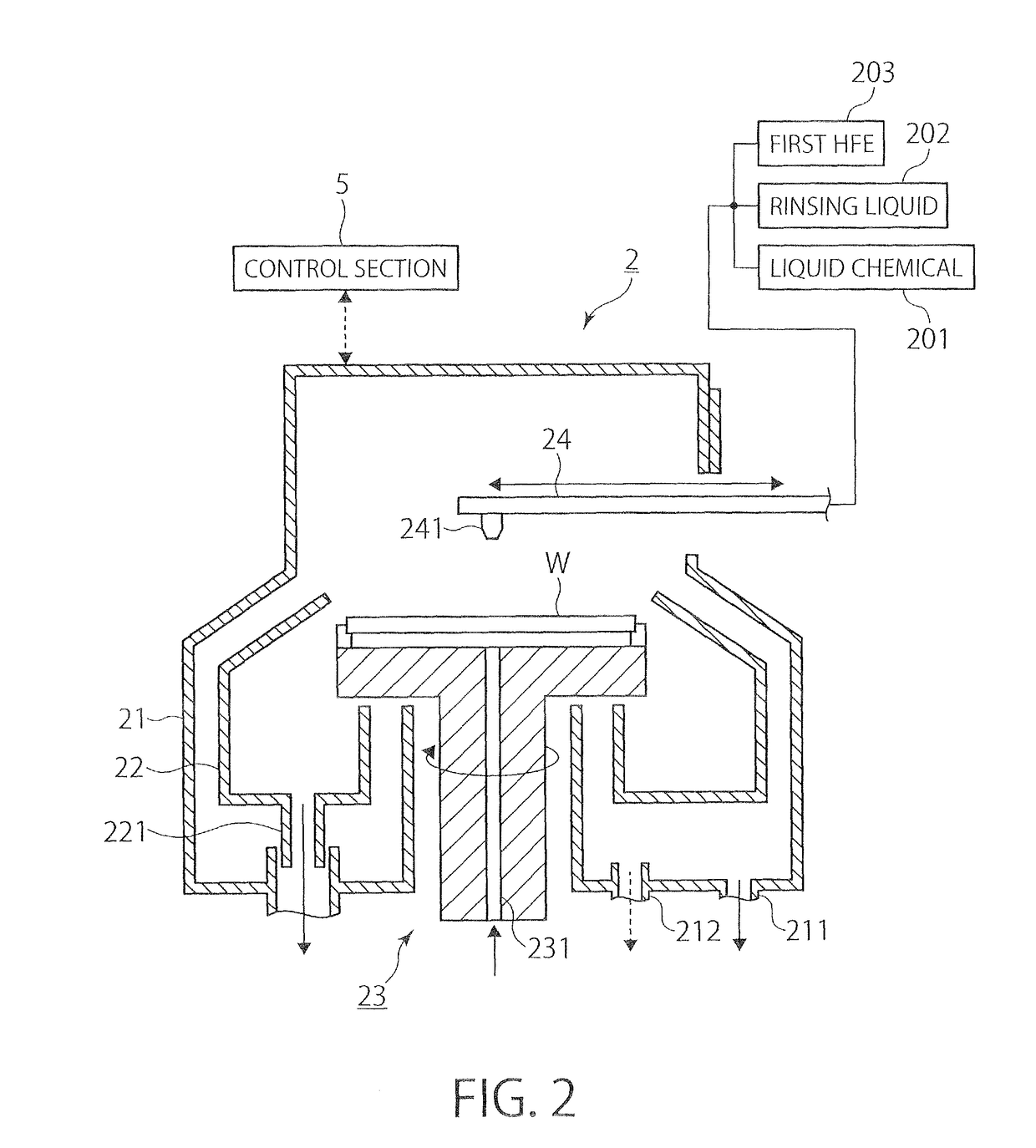Substrate processing method and storage medium
a processing method and substrate technology, applied in the direction of electrical equipment, cleaning processes and utensils, chemical equipment and processes, etc., can solve the problems of surface tension, surface tension acting sideways on the raised portion, and raising portion collapse, so as to prevent pattern collapse
Active Publication Date: 2018-10-09
TOKYO ELECTRON LTD +1
View PDF17 Cites 1 Cited by
- Summary
- Abstract
- Description
- Claims
- Application Information
AI Technical Summary
Benefits of technology
This method minimizes evaporation losses and prevents decomposition, reducing operational costs and preventing pattern collapse during the processing of semiconductor wafers.
Problems solved by technology
As semiconductor devices are becoming more highly integrated, a phenomenon called pattern collapse, which can occur when removing a liquid which has adhered to a wafer surface in such a liquid processing step, is becoming a serious problem.
The pattern collapse is a phenomenon in which a liquid, remaining on both sides of a raised portion (i.e. remaining in recessed portions) of a three-dimensional pattern, is unevenly removed upon drying of the wafer surface whereby a surface tension, acting sideways on the raised portion, becomes unbalanced and the raised portion collapses toward the side where a larger amount of the liquid remains.
In addition, no interface exists between a high-pressure fluid and a liquid or a gas in equilibrium with the fluid.
On the other hand, a fluorine-containing organic solvent such as HFE, HFC (hydrofluorocarbon) or PFC (perfluorocarbon) is more expensive than IPA (isopropyl alcohol) or the like; a loss of such a fluorine-containing organic solvent due to its evaporation during transportation of a wafer leads to an increase in the operating cost.
A fluorine-containing organic solvent having a high boiling point, however, generally has a high critical temperature, and therefore can decompose in a high-temperature and high-pressure atmosphere to generate hydrogen fluoride (HF), etc., which may cause damage to a wafer.
Further, when an anti-drying liquid having a high boiling point is brought into a processing container and the liquid is subjected to processing to remove the liquid, the resulting fluid can condense in the processing container, causing pattern collapse.
Method used
the structure of the environmentally friendly knitted fabric provided by the present invention; figure 2 Flow chart of the yarn wrapping machine for environmentally friendly knitted fabrics and storage devices; image 3 Is the parameter map of the yarn covering machine
View moreImage
Smart Image Click on the blue labels to locate them in the text.
Smart ImageViewing Examples
Examples
Experimental program
Comparison scheme
Effect test
example 1
[0082]As a result of observation of the specimen 70 of Example 1, pattern collapse was found only at a few sites in the surface. This verifies that the anti-drying liquid 601 can be removed from the surface of the specimen 70 while preventing the occurrence of pattern collapse even when using the closed system to which no fresh supercritical fluid is supplied from the outside.
the structure of the environmentally friendly knitted fabric provided by the present invention; figure 2 Flow chart of the yarn wrapping machine for environmentally friendly knitted fabrics and storage devices; image 3 Is the parameter map of the yarn covering machine
Login to View More PUM
 Login to View More
Login to View More Abstract
A substrate processing method and apparatus for preventing evaporation of an anti-drying fluorine-containing organic solvent from a substrate during transportation of the substrate into a processing container and can prevent decomposition of a fluorine-containing organic solvent in the processing container. A substrate, the surface of which is covered with a first fluorine-containing organic solvent, is carried into a processing container. The first fluorine-containing organic solvent is removed from the substrate surface by forming a high-pressure fluid atmosphere of a mixture of the first fluorine-containing organic solvent and a second fluorine-containing organic solvent, having a lower boiling point than the first fluorine-containing organic solvent, in the processing container e.g. by supplying a high-pressure fluid of the second fluorine-containing organic solvent into the processing container. Thereafter, a fluid in the state of a high-pressure fluid or a gas is discharged from the processing container to obtain the substrate in the dried state.
Description
CROSS-REFERENCE TO RELATED APPLICATIONS[0001]This application claims the priority benefit of Japanese Patent Application No. 2012-159850, filed on Jul. 18, 2012, the disclosure of which is incorporated herein by reference in its entirety.TECHNICAL FIELD[0002]The present invention relates to a technique for removing a liquid from a substrate surface by using a high-pressure fluid in a supercritical or subcritical state.BACKGROUND ART[0003]In a semiconductor device manufacturing process for forming a laminated integrated circuit structure in a surface of a semiconductor wafer (hereinafter simply referred to as “wafer”) as a substrate, a liquid processing step is provided for carrying out processing of a wafer surface, such as removal of small foreign matter or a natural oxide film from the wafer surface, e.g. by using a cleaning liquid such as a liquid chemical.[0004]As semiconductor devices are becoming more highly integrated, a phenomenon called pattern collapse, which can occur whe...
Claims
the structure of the environmentally friendly knitted fabric provided by the present invention; figure 2 Flow chart of the yarn wrapping machine for environmentally friendly knitted fabrics and storage devices; image 3 Is the parameter map of the yarn covering machine
Login to View More Application Information
Patent Timeline
 Login to View More
Login to View More Patent Type & Authority Patents(United States)
IPC IPC(8): H01L21/02B08B7/00H01L21/67
CPCH01L21/02101B08B7/0021H01L21/02041H01L21/67109H01L21/67017H01L21/67051H01L21/02057H01L21/302
Inventor HAYASHI, HIDEKAZUSATO, YOHEIOKUCHI, HISASHITOMITA, HIROSHIMITSUOKA, KAZUYUKIYOU, GENOHNO, HIROKIORII, TAKEHIKOTOSHIMA, TAKAYUKI
Owner TOKYO ELECTRON LTD
Features
- R&D
- Intellectual Property
- Life Sciences
- Materials
- Tech Scout
Why Patsnap Eureka
- Unparalleled Data Quality
- Higher Quality Content
- 60% Fewer Hallucinations
Social media
Patsnap Eureka Blog
Learn More Browse by: Latest US Patents, China's latest patents, Technical Efficacy Thesaurus, Application Domain, Technology Topic, Popular Technical Reports.
© 2025 PatSnap. All rights reserved.Legal|Privacy policy|Modern Slavery Act Transparency Statement|Sitemap|About US| Contact US: help@patsnap.com



